How to Choose
Horseback Riding Jeans
Find the Best Jeans to Help You Feel Confident In and Out of the Saddle!
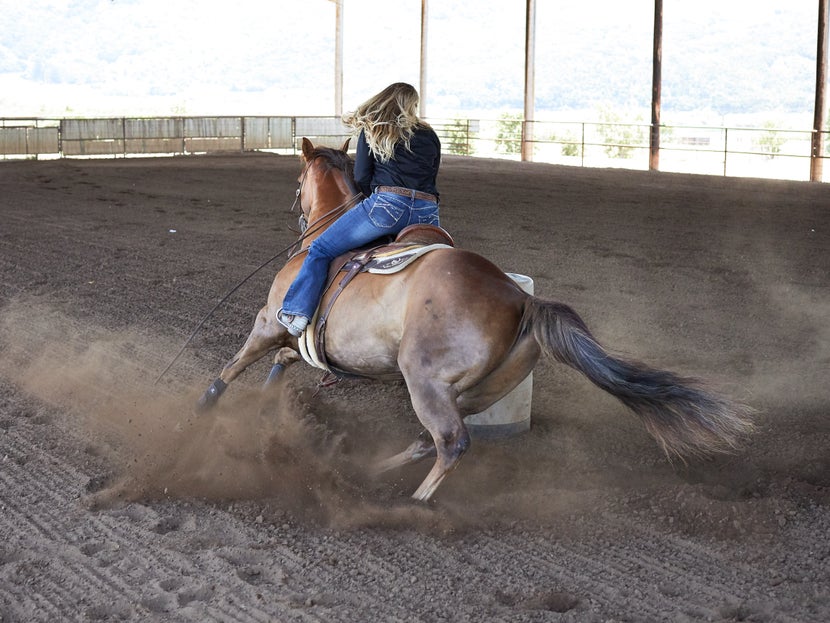
There's nothing quite like a good pair of jeans when it comes to keeping you covered and comfortable while you're in the saddle or working around the barn. No matter your discipline, fashion, or functional preferences, we believe everyone deserves a pair of jeans that can help them be their most confident self. Read on to learn more about jean terminology, so you can find the perfect pair of jeans based on rise, cut, material, and more. If you want to jump straight into our favorite jeans, check out our Best Women's Horseback Riding Jeans for the crew's top picks!
Selecting the Best Rise
of Horseback Riding Jeans
The "rise" on jeans refers to the distance between the crotch and the waistband. Denim jeans can come in low, mid, and high-rise options to accommodate various body types and personal preferences. The varying jean rises are bound to look different on different bodies, so knowing what fits and feels good for you is most important. Finding your rise preference might take more trial and error compared to other aspects of jeans, but it will be worth the effort!
Low-Rise: Low-rise jeans sit low on or below the hips. These jeans often measure seven to eight inches from the waistband to the fork (where the legs meet the crotch).
Mid-Rise: Mid-rise jeans sit between the hips and the navel, just below the natural waist. This is the most common rise option offered in jeans.
High-Rise: High-rise jeans have the longest distance from the waistband to the fork, sitting near to or above the belly button. They can give the appearance of longer legs.
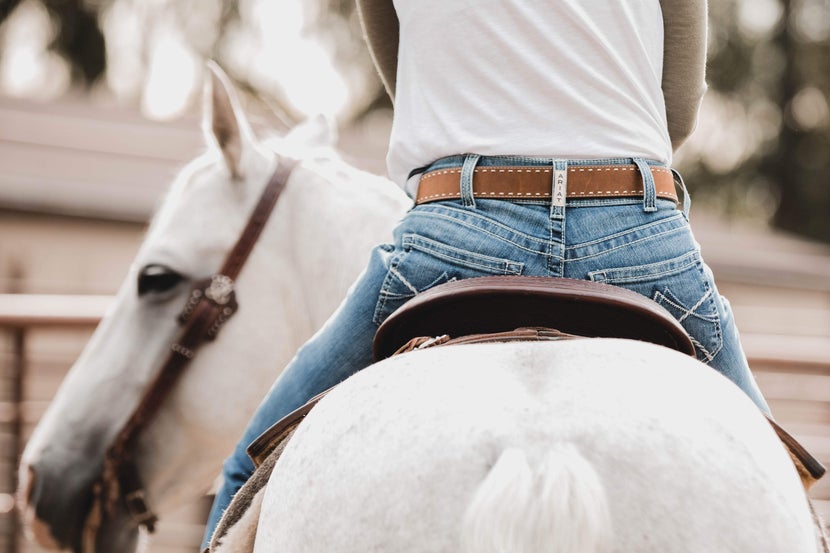
Mid-rise or high-rise jeans provide the most coverage and support while riding, so you don't have to constantly pull them up or worry about gapping in the back. Most jeans, regardless of the rise, will feel a little higher once you're in the saddle. Because of this, if you have a shorter torso, low- or mid-rise jeans might suit you better than high-rise jeans. Alternatively, if you have a long torso or high natural waist, mid- or high-rise options may be more comfortable.
Denim Jean Cut Styles
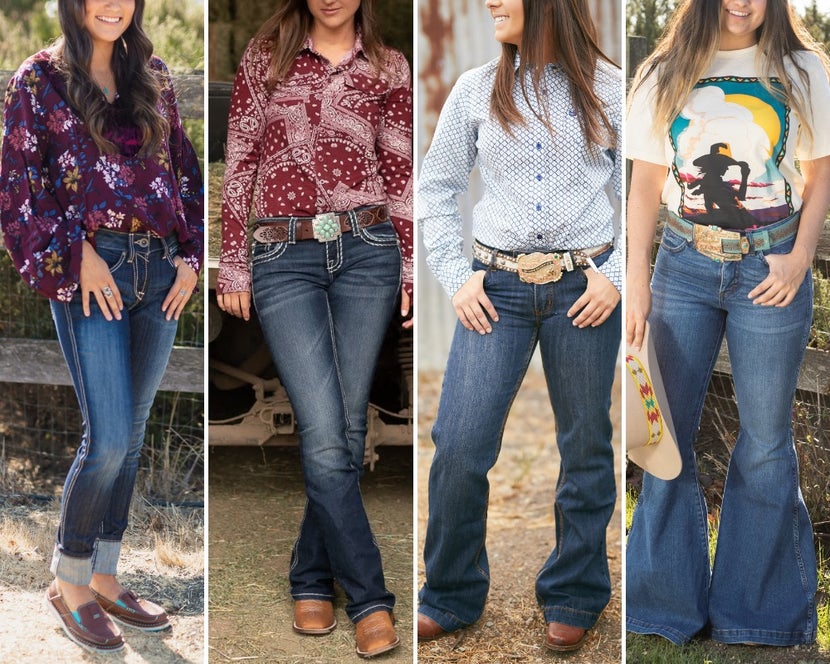
The "cut" refers to how the jeans fit your legs rather than your waist. There are many different types of jean cuts, and some styles are more appropriate for horseback riding than others. Let's dive into a breakdown of each jean cut style!
Bootcut
Bootcut jeans are the most common cut for horseback riding. Traditionally, bootcut is defined as a jean that is fitted around the knee then loosens around the calf and ankle. These jeans offer a slight flare so a boot can be worn underneath.
Cowboy-Cut
Similar to bootcut, the main difference in cowboy-cut jeans is the width of the lower leg. These jeans are tight through the thigh and knee and maintain the knee width down to the ankle. This cut fits over your cowboy boots but will be tighter around the lower leg, since it doesn't have the slight flare that bootcut jeans have.
Straight Leg
The straight leg cut does not have any flare to it. The width of the pants stays the same from the hip all the way to the ankle. They may give the appearance of a wide leg, since the thigh width is larger around the calves; however, the continuous shape becomes obvious when laid flat.
Trouser
Trouser jeans are fitted in the waist and through the hips, and the width of the pant leg expands through the thigh and knee. Finished with a wide-tailored "trouser hem," these jeans can give you the illusion of longer legs. A very popular cut, trousers often come in high-waisted and longer inseam options.
Flare
Flare jeans are fitted from the hip through the thigh, then become wider from the knee downward to form a bell-like shape. Considered fashion-style jeans, the cut flares out much more than necessary to accommodate a boot and may tangle or rub when riding due to the extra fabric.
Skinny
Skinny jeans are form-fitting from the waist all the way to the ankle. These can be low-rise, mid-rise, or high-rise and are usually made with stretchier fabric to compensate for the "second-skin" feel.
Boyfriend
The boyfriend jean style is typically fitted at the hips and in the seat with a more generous, relaxed cut through the legs. One way to think about it would be a wider straight-leg jean that is fitted at the hip and waist.
Girlfriend
A more feminine version of the boyfriend jean, girlfriend jeans have a more classic fit that is tighter and higher on the hip. They offer a tapered, slim straight leg while still being loose fitting.
Picking the Perfect Denim Jean
Material, Weight, & Wash
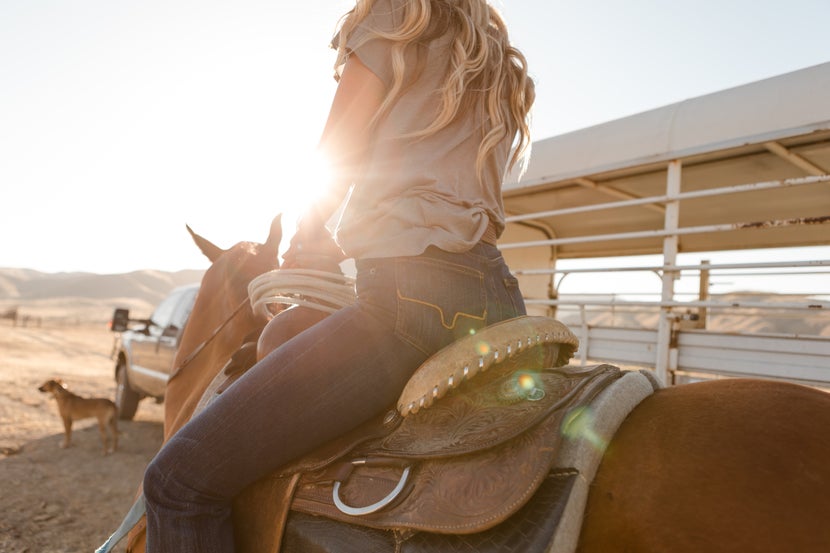
Material Blends in Jeans
In today's market, many jeans use a blend of 98% cotton and 2% spandex. Some jeans have a lower percentage of spandex with some polyester added, or vice versa. Make sure to check the product description for details on various product material blends if you have preferences or certain allergies. Most consumers prefer some stretch and give to their denim; however, there are denim companies that still offer 100% cotton jeans. Denim made solely from cotton does not stretch or give, so this jean material tends to be sought after by riders who want a more traditional feel to their jeans. Jeans made from 100% cotton are sturdier and tend to last longer.
Denim Weight
The idea of categorizing a pair of jeans by weight comes from the weight of a square yard of fabric in ounces, which relates directly to the density of yarn used.
|
Lightweight: Under 12 oz. |
|
Mid-weight: From 12 oz. to 16 oz. |
|
Heavyweight: Anything above 16 oz. |
Lightweight denim is easy to break in and tends to feel comfortable from the first day of use. This weight won't feel heavy on your legs. As lightweight denim fades, it will look much more worn compared to heavier denim.
Mid-weight denim is the most common denim on the market today. This weight can start off stiff to the touch but is well worth it, since mid-weight denim creates a much longer-lasting pair of jeans and still wears in relatively quickly. Since mid-weight denim is a bit thicker, it's a nice choice for fall and winter.
Heavyweight denim is extremely stiff, and jeans made from this type of denim will take a longer time to break in before they are comfortable. On the plus side, these jeans will last a lifetime. Typically, men's jeans are made from heavyweight denim due to their high durability and generally looser fit.
Jean Wash
Light-wash jeans are created using the longest washing process to remove even more of the indigo dye from the jeans. Light wash jeans tend to be a more popular choice for fashion since this color shows dirt when riding or doing barn chores. Light-wash jeans don't absorb heat like medium- or dark-wash jeans, so they can be a good choice for riding in warmer weather.
Medium-wash jeans are the most popular wash option on the market. The color is achieved with a longer washing process during manufacturing to remove the indigo dye color. Medium-wash jeans tend to be softer compared to dark denim and create more of a casual look than dark-wash jeans. There are many variations within medium-wash denim so you might end up with an array of medium-wash options!
Dark-wash jeans can be a good choice for formal occasions, since the dark color resembles slacks. Keep in mind that dark colors do tend to absorb heat, so these might make you a little toasty in warm weather. Oftentimes, dark jeans are considered fashion jeans rather than riding jeans, but personal style will determine that for you! Dark denim tends to be a bit stiffer than other washes due to its shorter washing process during manufacturing, so if you are looking for instant comfort you might steer toward something lighter.
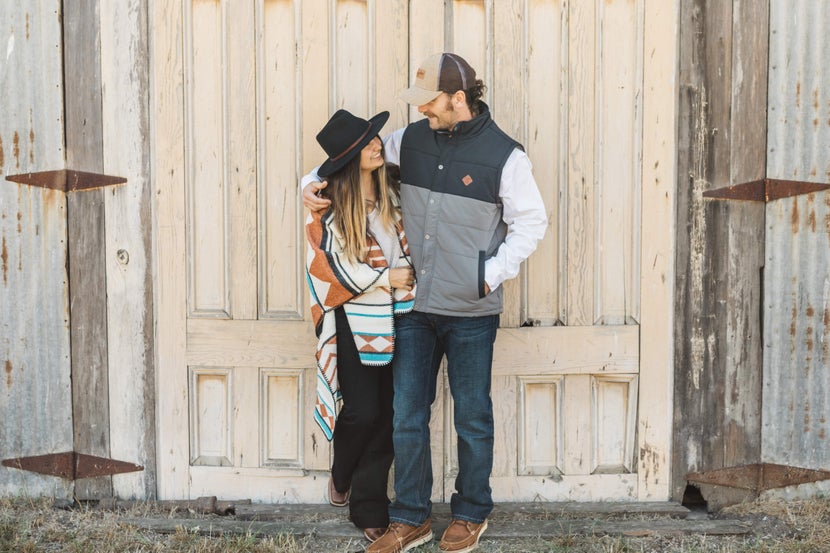
Additional Denim Jean Features
Pockets: While jeans with embellished or "bling" pockets are eye-catching, the embellishments can leave marks on your saddle that might not be able to be repaired. Flat-stitched pockets are a better choice to preserve the integrity of your saddle.
No-Gap Waistband: Some jeans feature a band made from stretchy material sewn into the waist. This keeps your jeans in place while working and makes sure you do not have a gap in the back while sitting in the saddle. You will find that most jeans with a no-gap waistband are mid-rise.
Flexible Knee: Bootcut, cowboy cut, and trouser jeans are looser through the knee, so you won't feel restricted in the saddle. Bootcut and trouser jeans will fit over the vast majority of riding boots as well, which is a major contributor to both looks and comfort!
Flat Seams: Most horseback riding jeans have flat seams down the inside of the leg, since this design feature is much more comfortable when pressure is applied. Raised seams can dig into the side of your leg while in the saddle and leave marks or even bruises.
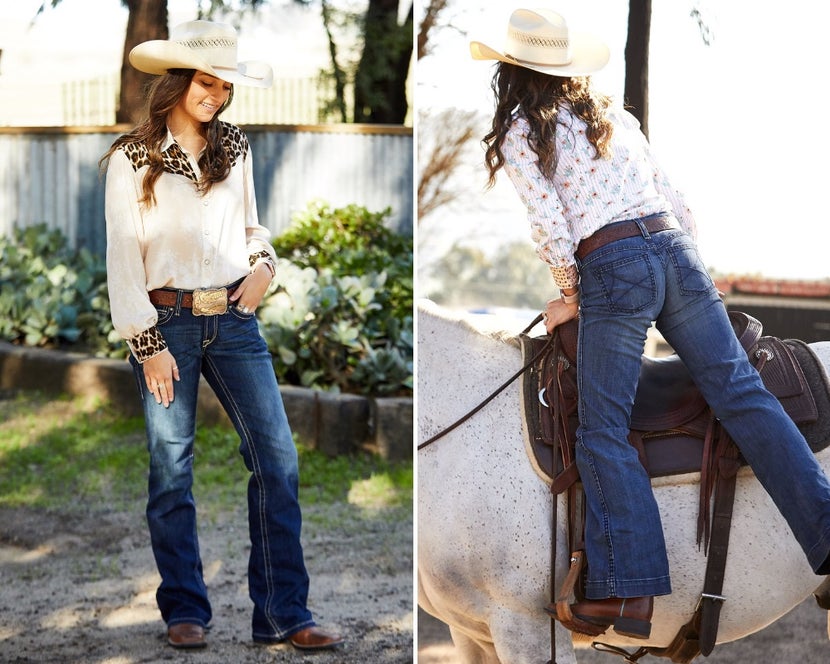
Finding Your Jean Size
Finding the perfect fit when shopping for jeans online can be tough, since you don't get to try them on before purchasing. Ensure you get the best guess on the right size for you by taking a look at the manufacturer's sizing chart on the product page. Measure yourself using a soft measuring tape, then compare your measurements to the sizing chart.
It's also important to know your inseam measurement for riding jeans, as you'll want to make sure they are long enough when your knee is bent in the saddle. The best way to find your inseam measurement is by measuring from the fork to the hem on a pair of riding jeans you already own that are a good length for riding. If none of the jeans you currently have are a good riding length, add about 2 inches to your normal inseam length to get your riding length.
Proper Denim Jean Care
After you've found your perfect pair of jeans, it takes a little care to keep them in their best shape. To maintain the fit and integrity of your jeans, it is best to wash them in cold water with like colors. Be sure to hang dry your jeans if you want to avoid shrinking. If you find your jeans becoming a bit stretched out with age, you can toss them in the dryer on medium heat to tighten the fibers in the denim back up and help give them shape again.
Closing Thoughts
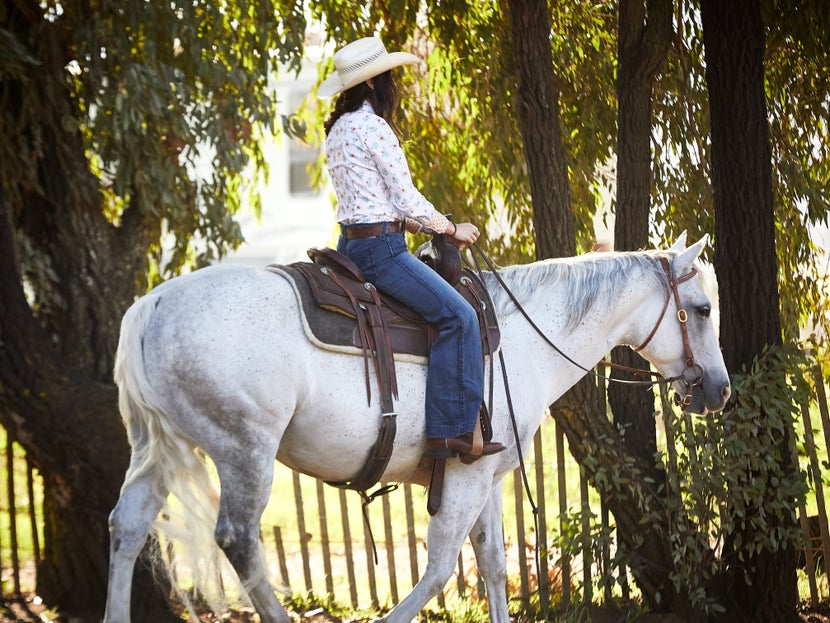
With so many trusted brands, tried and true cuts, and personal styles at play, the possibilities for denim are endless! For riding in the saddle or wearing out on the town, the right pair of jeans can add confidence, comfort, and some peace of mind to your day. Still unsure which pair is right for you? Feel free to call our friendly customer service department at 1-800-620-9145, or email us at info@ridingwarehouse.com. Happy shopping!

